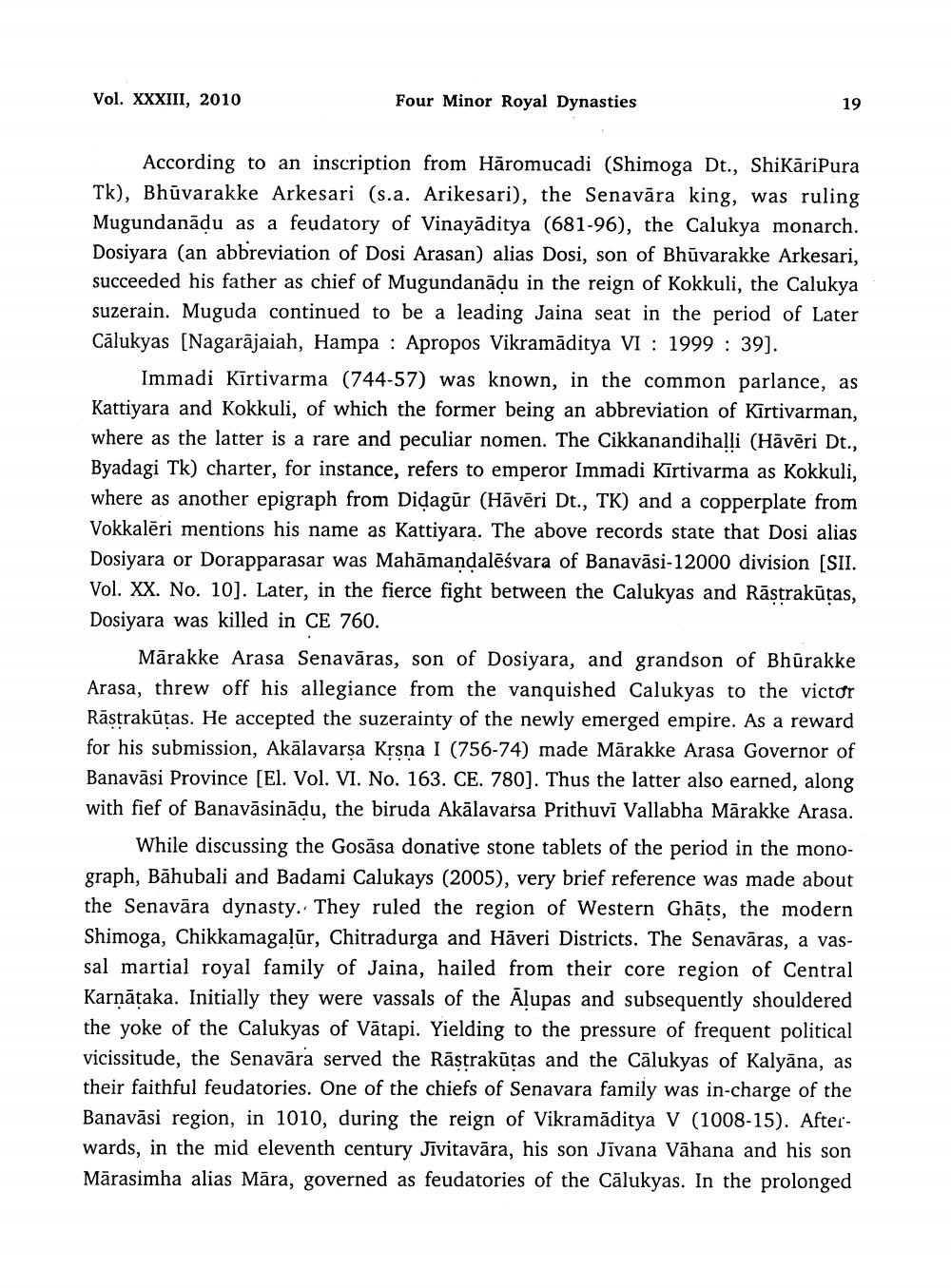________________
Vol. XXXIII, 2010
Four Minor Royal Dynasties
According to an inscription from Hāromucadi (Shimoga Dt., ShiKāriPura Tk), Bhuvarakke Arkesari (s.a. Arikesari), the Senavāra king, was ruling Mugundanādu as a feudatory of Vinayāditya (681-96), the Calukya monarch. Dosiyara (an abbreviation of Dosi Arasan) alias Dosi, son of Bhūvarakke Arkesari, succeeded his father as chief of Mugundanāļu in the reign of Kokkuli, the Calukya suzerain. Muguda continued to be a leading Jaina seat in the period of Later Cālukyas (Nagarājaiah, Hampa : Apropos Vikramāditya VI : 1999 : 39).
Immadi Kīrtivarma (744-57) was known, in the common parlance, as Kattiyara and Kokkuli, of which the former being an abbreviation of Kirtivarman, where as the latter is a rare and peculiar nomen. The Cikkanandihalli (Hāvēri Dt., Byadagi Tk) charter, for instance, refers to emperor Immadi Kirtivarma as Kokkuli, where as another epigraph from Didagūr (Hāvēri Dt., TK) and a copperplate from Vokkalēri mentions his name as Kattiyara. The above records state that Dosi alias Dosiyara or Dorapparasar was Mahāmandalēśvara of Banavāsi-12000 division (SII. Vol. XX. No. 10]. Later, in the fierce fight between the Calukyas and Rāstrakūtas, Dosiyara was killed in CE 760.
Mārakke Arasa Senavāras, son of Dosiyara, and grandson of Bhūrakke Arasa, threw off his allegiance from the vanquished Calukyas to the victor Rāstrakūtas. He accepted the suzerainty of the newly emerged empire. As a reward for his submission, Akālavarsa Krsna I (756-74) made Mārakke Arasa Governor of Banavāsi Province [El. Vol. VI. No. 163. CE. 780]. Thus the latter also earned, along with fief of Banavāsinādu, the biruda Akālavarsa Prithuvi Vallabha Mārakke Arasa.
While discussing the Gosāsa donative stone tablets of the period in the monograph, Bāhubali and Badami Calukays (2005), very brief reference was made about the Senavāra dynasty. They ruled the region of Western Ghāts, the modern Shimoga, Chikkamagalūr, Chitradurga and Hāveri Districts. The Senavāras, a vassal martial royal family of Jaina, hailed from their core region of Central Karnātaka. Initially they were vassals of the Alupas and subsequently shouldered the yoke of the Calukyas of Vātapi. Yielding to the pressure of frequent political vicissitude, the Senavāra served the Rāstrakūtas and the Cālukyas of Kalyāna, as their faithful feudatories. One of the chiefs of Senavara family was in-charge of the Banavāsi region, in 1010, during the reign of Vikramāditya V (1008-15). Afterwards, in the mid eleventh century Jivitavāra, his son Jīvana Vāhana and his son Mārasimha alias Māra, governed as feudatories of the Cālukyas. In the prolonged




